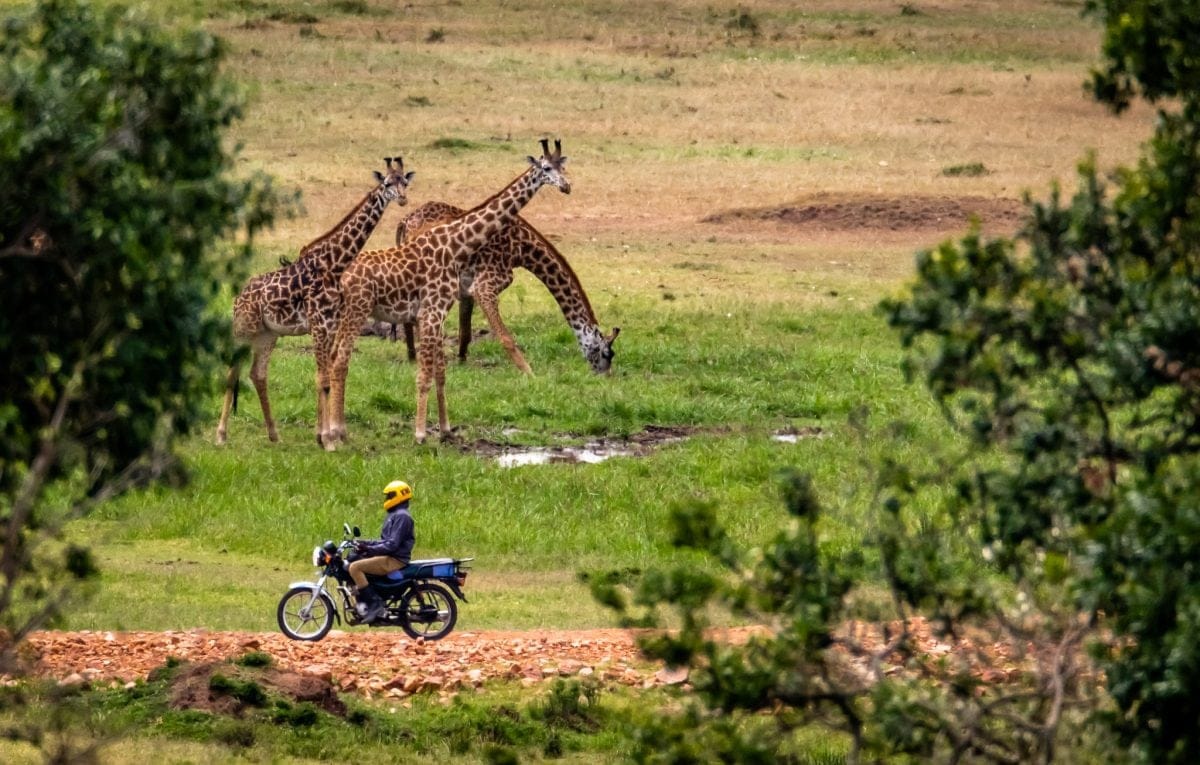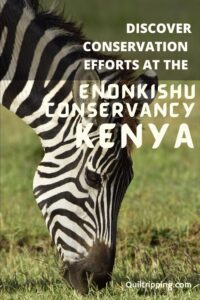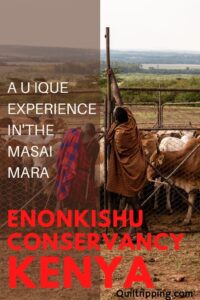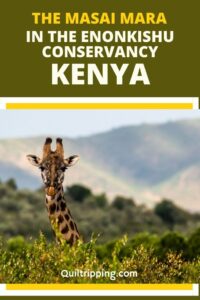Last Updated on 02/25/22 by Rose Palmer
It’s four in the morning and I am sitting in a blind at a waterhole in the midst of Kenya’s famous Maasai Mara ecosystem. The visible sky beyond the blind is covered in so many stars that I finally have a sense for how big a million-billion really is.
On the ground though, my visibility is limited to just a few feet in the absolute darkness beyond the confines of the branches and sticks that make up this makeshift enclosure that surrounds me. In the pitch blackness, I can’t detect the animals I am here to observe without the aid of night vision binoculars, but the cacophony of sounds leaves no doubt that I am completely surrounded by life. A loud orchestra of frogs, toads and insects serenades me so that I can easily stay awake during my shift. An occasional bark from a hyena or grunt from a hippo reminds me that larger four legged creatures also prowl the night. The local leopard though is nowhere to be seen or heard tonight.
 This post was recognized by the North America Travel Journalists Association (NATJA) in the 2019 awards competition with a Bronze award in the Featured Photo, Illustration– Online category.
This post was recognized by the North America Travel Journalists Association (NATJA) in the 2019 awards competition with a Bronze award in the Featured Photo, Illustration– Online category.

As the stars fade with the approaching dawn so do the night sounds. In their place, a chorus of birds start singing as the new day approaches. The sun slowly rises on the distant horizon, burning off the morning fog and warming up the trees and grassy plains beyond the waterhole. First, a few zebras appear in my line of sight, then some giraffes, followed by impalas and warthogs. Another day is starting in the Mara, and I can now do the job that brought me here: counting the wildlife that has become so abundant in the fledgling Enonkishu Conservancy.
On the Frontline of Conservation at the Enonkishu Conservancy
The young Enonkishu Conservancy is on the furthest northern edge of the Maasai Mara landscape in Kenya and is often referred to as the “Last Line of Defence” between human encroachment and wildlife conservation. The better known Maasai Mara National Reserve (and the connecting Serengeti National Park in Tanzania) are government owned lands and only protect a portion of the Mara ecosystem.

Encircling the Mara reserve in Kenya are a number of privately-owned conservation organizations that have been set up to extend the amount of protected habitat for wildlife. Before the introduction of the conservancies, this landscape was divided into small, family owned parcels which were used for grazing, agriculture and village communities.
The conservancies work with the local landowners, leasing the land and setting aside large zones that have been left to return to their natural state. This has encouraged the expansion of Kenya’s indigenous wildlife, and with it, the opportunities for managed tourism. The tourism in turn provides the income and increased financial resources to the landowners from whom the land was leased. It is a circle of life in which everyone benefits, and the wildlife most of all.

I am at the Enonkishu Conservancy as a citizen scientist with Biosphere Expeditions, a nonprofit organization that provides volunteer opportunities in the field of wildlife conservation. In this inaugural biodiversity study, I am one of twelve volunteers who are here from all corners of the globe because we want to play a role in the protection of this amazing environment. And (let’s be honest) because we want to see the animals.
Looking at the great variety of herbivores now grazing on the abundant grass at Enonkishu, it is hard to believe that only a few years ago, this land had been barren and overgrazed by cattle.

Cows also need grass to survive, and to Kenya’s Maasai people, their cattle are an integral part of their culture. The cows are more than just a critical source of food – they also represent status and tangible wealth, much like the automobile does in western society. In this still very traditional life style, a Maasai man’s primary job is to take care of the cattle, protect his family’s livelihood and to increase his wealth by getting more livestock.

So how do you get from a dry and almost useless overgrazed landscape to a virtual garden of Eden? With tenacity, perseverance, charisma, passion and a lot of innovative thinking.
Starting the Enonkishu Conservancy was the brainchild of Tarquin and Lippa Wood. Tarquin is a third generation Kenyan whose grandfather came from England in the 1970’s to set up a farm on the slopes of Mt. Kenya. Two generations later, Kenya and farming are still deeply ingrained in his blood. He and his wife Lippa settled in the Enonkishu area in 2000 and have worked through a number of enterprises on their land. In 2010, they decided to set up a conservancy with the long-term goal of attracting tourism – maybe an easy idea on paper but a lot of long and hard work in practice.
To make the conservancy viable first meant convincing the surrounding individual land owners to hand over the management of their land (and their cattle) to the conservancy – only a fraction of them bought into the idea. In exchange for leasing the land, the conservancy committed to giving the landowners a regular paycheck, even though in 2010, the designated landscape was horribly overgrazed with no grass and no wild animals in sight.

The solution: implementing a number of pioneering renewable conservation practices and acknowledging that conservation, enterprise and societal needs do not have to be mutually exclusive. Another key aspect has been to embrace the Maasai cattle culture rather than excluding it in favor of the wildlife. Using a holistic model that supports sustainable rangeland management, the Woods and the Enonkishu team have “rewilded” the landscape into a model wildlife ecosystem.

Surprisingly, the key to this rehabilitation program has been the Maasai cattle themselves. Where the cattle were once left to graze wherever it was convenient, the cattle that make up the combined landowner’s herd must now follow a controlled grazing plan. The conservancy is divided into blocks with the cattle grazing in a different block on a planned rotation schedule.
To control unwanted grazing, one of the conservancy rangers’ jobs is to make sure that no unauthorized grazing occurs as outsiders try to bring their cows onto land they are not allowed to use. (If caught, a cattle owner can be charged hefty fines for illegal grazing). This managed grazing plan has allowed the grass to grow and spread and keeps it from becoming overgrazed.


The cattle are also the prime ingredient for effectively reseeding the barren ground. At night, they are kept and protected in movable “bomas,” or fenced enclosures. As the cattle move about in the circular enclosure their hooves dig up and loosen the ground, acting as a living earth tiller. The cow dung, which is full of undigested seed falls onto the freshly broken up soil and is also “worked in” by the hooves. The boma is then moved to a different spot, and the naturally tilled and seeded earth is left to grow a new batch of virgin grass.
At one time these cattle were the source of habitat destruction but now they are the drivers of habitat creation.


Perhaps the most effective though less visually impressive improvement has been the ability to get the Maasai cattle owners to buy into the concept that quality is better than quantity. The conservancy plan limits the total number of cows that the program can support, and as a result, with more than enough food and routine care, the quality of the cattle has increased.
The Enonkishu team has also introduced bulls of a more robust cattle variety which has contributed to subsequent livestock generations that produce a better-quality beef product. Better beef, better market prices, better income and a better quality of life for all the Maasai families.

Once the grass returned, so did the wild animals. Zebras, wildebeests, warthogs and all manner of East African antelope need green grass to survive. And where there are grass eaters, the predators follow – hyenas, leopards, and the top of the food chain, lions. These many species of wild animals are Africa’s legacy. They exist only in this part of the world and provide a steady source of safari game viewing income to a continent that is trying hard to balance the growing needs of an expanding population.
As the Enonkishu Conservancy comes into its full potential, the resulting tourism also provides employment to the local villagers. Rangers, guides, drivers, cooks, waiters, housekeepers and other support services offers a source of income and an expanding skill set where there was none before.

But at Enonkishu, the tourism innovation does not stop with typical luxury lodging accommodations. A strip of land bordering the conservancy is also being developed into high end, low impact luxury homes. The cost of the homes in the Naretoi development includes fees in support of the conservancy. Basically, if you want the privilege of watching a zebra graze from your back porch, you have to be willing to financially support its environment.

Managing conservation as a business means that you need data to determine your effectiveness. Without data, you cannot improve, nor can you justify your course of action. That’s where I and my fellow Biosphere Expeditions citizen scientist volunteers came in. Over the course of the ten-day monitoring program, our team collected an astounding amount of baseline data.
While riding in the backs of trucks, walking in the bush, or sitting in a blind at a water hole, we observed, measured and recorded all the animals that crossed our path. We counted 4541 animals observations across 28 mammal species. If you add birds into the mix, that’s an additional 107 species. And even though we collectively spent hundreds of hours observing and counting, it was work with a purpose. And seeing the wild animals interacting in their native habitat never got old.

Wildlife or cattle. Conservation or Enterprise. Tourism or traditional life styles. The Enonkishu Conservancy has shown that one does not have to be at the exclusion of the other – they can all be nurtured and balanced hand in hand while at the same time respecting the age old Maasai heritage.
With the right kind of help Mother Nature is resilient. If you are interested in participating as a volunteer citizen scientist, you can read my detailed post about Volunteering as a Citizen Scientist in Kenya .
To learn more about the efforts at the Enonkishu Conservancy, please check out https://www.enonkishu.org/ .
To see an interview with Tarquin Wood about the conservation efforts, filmed by Chris Taylor, one of the other citizen scientists that attended with me, please check out https://www.youtube.com/watch?v=I4BHPdCztnc&feature=youtu.be
To experience the Enonkishu Conservancy yourself, you can stay at one of the House in the Wild options.
Please note that I was a guest of Biosphere Expeditions on my trip to Kenya. All content is my own.
Other Kenya stories you may enjoy:
25 wildlife photos from the Enonkishu Conservancy: 25 Photos to Inspire You to Visit the Enonkishu Conservancy in Kenya
How to enjoy a Kenya beach holiday: A Sunny Italian Kenya Beach Resorts Experience – My Favorite Alternative to the Seychelles
Discover the unique Gedi Ruins: Get Thee to the Gedi Ruins
A perfect day on a Masai Mara safari: Into Africa – A Perfectly Wild Day On a Masai Mara Safari
From Kenya to Qatar to the Czech Republic: Discovering a World of Diversity in 72 Hours
Thanks for visiting.
Rose
Pin this!






